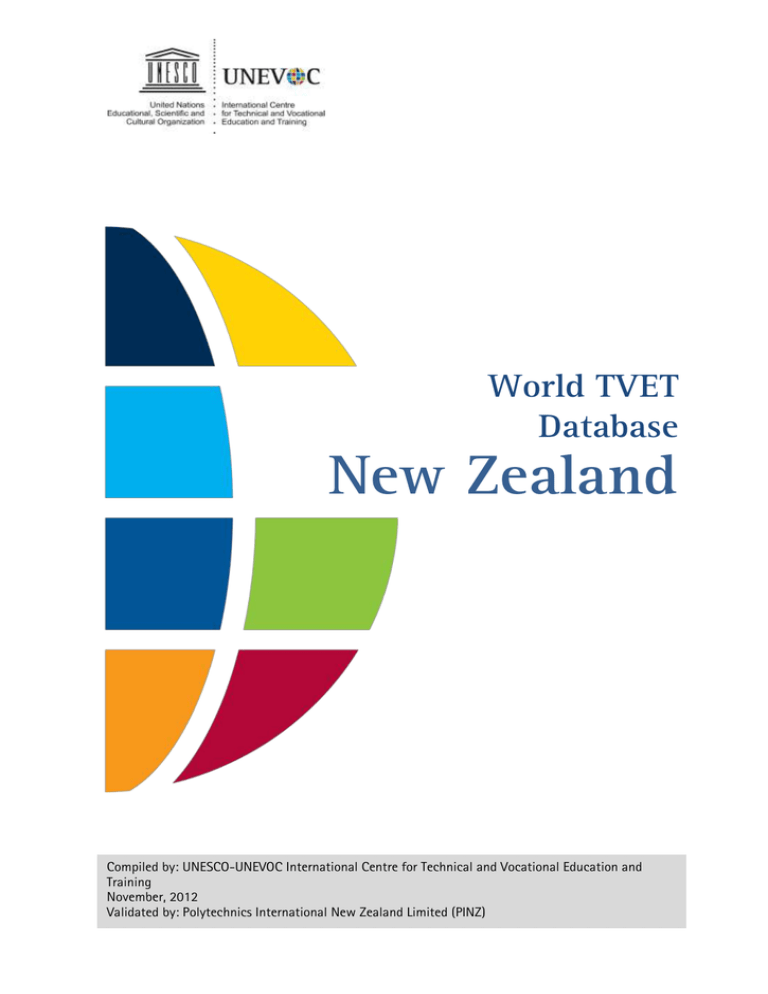
World TVET
Database
New Zealand
Compiled by: UNESCO-UNEVOC International Centre for Technical and Vocational Education and
Training
November, 2012
Validated by: Polytechnics International New Zealand Limited (PINZ)
World TVET Database New Zealand
November, 2012
Compiled by
UNESCO-UNEVOC International Centre for
Technical and Vocational Education and Training
UN Campus
Platz der Vereinten Nationen 1
53113 Bonn
Germany
Tel: +49 228 815 0100
Fax: +49 228 815 0199
www.unevoc.unesco.org
unevoc@unesco.org
Country profiles are compiled from a variety of national and international sources and have
been informed and validated by UNEVOC Centres in the country or other TVET national
authorities.
The designations employed and the presentations of material throughout this report do not
imply the expression of any opinion whatsoever on the part of UNESCO concerning the legal
status of any country, territory, city or area or of its authorities, or concerning the delimitation
of its frontiers or boundaries.
UNEVOC/2012/TVETDB/NZL/1
© UNESCO 2015
All rights reserved
2 | Compiled by UNESCO-UNEVOC (http://www.unevoc.unesco.org/)
World TVET Database New Zealand
November, 2012
Contents
Abbreviations ....................................................................................................................................................4
1. TVET mission, strategy and legislation ...................................................................................................5
2. TVET formal, non-formal and informal systems ..................................................................................7
3. Governance and financing ........................................................................................................................9
4. TVET teachers and trainers ..................................................................................................................... 10
5. Qualifications and Qualifications Frameworks ................................................................................. 11
6. Current reforms, major projects and challenges .............................................................................. 11
7. Links to UNEVOC centres and TVET institutions ............................................................................... 12
8. References and further reading ............................................................................................................ 12
3 | Compiled by UNESCO-UNEVOC (http://www.unevoc.unesco.org/)
World TVET Database New Zealand
November, 2012
Abbreviations
ITO
ITP
NZQA
NZQF
NZTC
OJT
PTE
Industry Training Organisation
Institutes of Technology and Polytechnics
New Zealand Qualifications Authority
New Zealand Qualifications Framework
New Zealand Teachers Council
On-Job Training
Private Training Establishments
TVETipedia Glossary
Below are listed TVET terms mentioned in this report. Click on a term to read its definitions on
the UNESCO-UNEVOC TVETipedia glossary.
Accreditation
Non-formal education
Adult education
Off-the-job training
Apprenticeship
On-the-job training
Assessment
Prior learning
Audit
Qualification
Career advice/counselling
Quality
Certificate
Quality Assurance
Cooperative learning
Skill needs
Diploma
Skills
Distance learning/education
Skills development
Formal Education And Training
Stakeholder
General education
Standard
Informal Learning
Teacher
In-service programme/training
Teacher In VET
Internship
Tertiary Education
Job
Trainer
Knowledge
TVET
Labour market
Work experience
National Qualifications Framework
4 | Compiled by UNESCO-UNEVOC (http://www.unevoc.unesco.org/)
World TVET Database New Zealand
November, 2012
New Zealand
Population:
Youth population1:
Median population age:
Annual population growth
(2010-2015)2:
4,529,000 (2015)
630,000 (2015)
38.0 (2015)
0.72%
Data © OpenStreetMap Design © Mapbox
1. TVET mission, strategy and legislation
TVET strategy
The Skills Strategy (2008)
training.
aims to integrate workplace needs into formal education and
The Strategy sets out 5 goals which aim to create a competitive workforce in New Zealand.
Goal 1 Improve the use and retention of skills to transform work and workplaces;
Goal 2 Increase employer and worker awareness of their skills needs;
Goal 3 Influence the supply of skills through a more responsive education and training
system;
Goal 4 Develop a unified approach to defining, valuing and measuring skills;
Goal 5 Make the most of the available workforce by supporting everyone to work,
through skills development and supportive workplace practices.
To achieve these goals, the Strategy concentrates on four areas.
“Improve management and leadership capability in organisations to better develop and
use skills.”
For that purpose, partnerships between firms and tertiary education providers; and
public – private partnerships should be established.
“Increase the literacy, language and numeracy skills of the workforce.”
A larger number of literacy and numeracy programmes relevant to the labour market
should be offered, and awareness raising on advantages of literacy and numeracy
should be undertaken.
“Create a better match between workers’ skills and industry and regional needs.”
1
Population aged 14-25
All statistics compiled from the United Nation’s Population Division’s World Population Prospects, the
2015 Revision (http://esa.un.org/unpd/wpp/DVD/)
2
5 | Compiled by UNESCO-UNEVOC (http://www.unevoc.unesco.org/)
World TVET Database New Zealand
November, 2012
Access to career advice services and labour market information should be increased and
information on skill needs should be elaborated according to regions. The qualifications
system should be reviewed.
“Support young people currently in the workforce to increase their skills and engage in
relevant training.”
Advice services for employers and training providers on how to support young workers
should be offered. Further, labour market information and career advice should be
improved for young job seekers.
The Tertiary Education Strategy (2010-2015) sets out to create a world-leading education
system. One of its priorities is to “raise the skills and knowledge of the current and future
workforce to meet the labour market demands and social needs.” The Strategy recognises that
skills are crucial for securing long-term productivity and future growth.
TVET legislation
The Education Act (1989) and its subsequent Education Amendment Act No. 3 (2010)
form the main legislative framework for the education system. The Education Act
(1989) established the New Zealand Qualifications Authority (NZQA) and the Teachers
Registration Board.
Industry training was initiated with the passing of the Industry Training Act (1992)
which stipulates the establishment of Industry Training Organisations (ITOs). ITOs are
charged with managing training in their industry. The Industry Training Amendment Act
(2002) was endorsed to improve the quality of the industry training system.
6 | Compiled by UNESCO-UNEVOC (http://www.unevoc.unesco.org/)
World TVET Database New Zealand
November, 2012
2. TVET formal, non-formal and informal systems
Scheme compiled by UNESCO-UNEVOC from UNESCO-IBE (2011). World Data on Education VII
Ed. 2010/11. New Zealand. Geneva: UNESCO-IBE.
Formal TVET system
Primary education starts at the age of five and lasts until the sixth year of schooling. At
secondary level students may specialise in technical and vocational subjects or choose
complementary TVET (including bridging arrangements with tertiary providers) as part of general
secondary education.
Tertiary education is generally understood as including all types of post-secondary education.
The boundaries among institutions and other providers of post-school education and training
are not rigidly imposed in New Zealand so TVET can be found in schools and in universities.
7 | Compiled by UNESCO-UNEVOC (http://www.unevoc.unesco.org/)
World TVET Database New Zealand
November, 2012
Students can choose to continue with technical and vocational education and training (TVET);
continuing or higher education in a range of learning environments.
At tertiary level, the following providers offer TVET training:
Private training establishments;
Government training establishments;
Wānanga (tertiary institutions providing education in Māori cultural context);
Industry training organisations;
Course owners;
Institutes of technology and polytechnics; and
Adult education providers.
There are also TVET courses available in a number of universities.
Institutes of Technology and Polytechnics (ITPs) provide a range of TVET programmes ranging
from introductory to full degree courses. They focus on practical knowledge and its application
to work-related environments. There are 20 ITPs in New Zealand.
Main characteristics of ITP education are listed below and include:
Practical teaching takes place in studios, workshops, laboratories, hospitals and other
workplaces;
Professional and applied degrees are based on applied research;
Certificate and diploma programmes are industry-related;
Many programmes include compulsory work experience such as internships, cooperative
leaning and On-the-Job Training (OJT);
ITP offer a range of academic and professional programmes with a range of
qualifications;
ITP encourage students to build up from lower to higher qualifications;
ITP offer distance learning and accessibility for students living outside cities; and
ITP graduates receive nationally and internationally recognised qualifications.
Non-formal and informal TVET systems
Private Training Establishments (PTE) provide TVET at tertiary level. They specialise in niche
occupations such as tourism, design, ICTs and English language learning and offer graduates
diplomas and certificates.
TVET training is also provided by Industry Training Organisations (ITO). ITOs are governmentfunded bodies representing their respective industries. They develop industry skill standards and
qualifications; and provide on-the-job training and contract training providers to offer off-job
training courses.
Informal TVET is part of what is termed prior learning. Prior learning is given consideration on
the basis of on-job experience, previous proven achievements outside formal learning or
assessment tasks. Assessment tasks are evaluated by accredited providers and registered
workplace assessors on the basis of standards in mainstream education and training
8 | Compiled by UNESCO-UNEVOC (http://www.unevoc.unesco.org/)
World TVET Database New Zealand
November, 2012
programmes. Training providers can also award credit for existing qualifications if they are
certain that unit standard requirements were met.
3. Governance and financing
Governance
The Ministry of Education is the main public body in charge education in New Zealand. It plays
a central role in administering education property; developing guidelines and curricula
statements; paying salaries and providing funding at the primary and secondary level.
The Tertiary Education Commission (TEC) is the government agency responsible for managing
the tertiary education sector. This encompasses all forms of post-school education and training.
Tertiary education institutions are responsible for administering their own capital works, paying
salaries and developing their own qualifications.
Under the supervision of the Ministry of Education, the New Zealand Qualifications Authority
(NZQA) is in charge of developing and maintaining a comprehensive, accessible and flexible
New Zealand Qualifications Framework (NZQF). It also serves as a register for the qualifications
of all post-schooling institutions (except universities), provides quality assurance and promotes
recognition internationally of New Zealand qualifications.
The Education Review Office is in charge of reporting on educational institutions at the primary
and secondary level and thus provides information on education quality of New Zealand schools
to all relevant stakeholders.
Careers New Zealand is a service available to all New Zealanders seeking advice on career paths
and related education requirements. It cooperates with industry, business, trade unions,
government agencies and educational institutions.
In TVET, industry training is coordinated by the Industry Training Organisations (ITOs). ITOs
represent their respective industries and other relevant stakeholders that make up the industry
training system. The system started evolving from the vocational training and apprenticeship
system in 1992. The Industry Training Federation is an umbrella organisation representing 33
ITOs to government agencies and sector groups.
The three main functions of the ITOs are (1) to provide information on industry skill demand, (2)
define national skill standards required by industry, (3) and broker training to meet the needs of
employees in industry. Industry training is offered both in traditional trades and new areas such
as services and retail.
List of accredited ITOs: http://www.nzqa.govt.nz/for-business/ito.do.
Financing
Funding is primarily from government through TEC, with contributions from industry and in
most cases, from student fees.
9 | Compiled by UNESCO-UNEVOC (http://www.unevoc.unesco.org/)
World TVET Database New Zealand
November, 2012
Literacy and numeracy skills were identified as one of the priorities in the Tertiary Education
Strategy 2007 -12. Therefore, an investment ($168 million over four years) into improving
literacy and numeracy – including programmes for numeracy and literacy skills in the workforce
- is outlined in the Budget 2008.
The table below shows funding for building demand, supply and capacity:
Source: Skills Strategy, 2008.
The Tertiary Education Commission is the main public body in charge of implementing the work.
Other agencies include employees, unions, Industry Training Organisations (ITO), Institutes of
Technology and Polytechnics and other tertiary education providers.
4. TVET teachers and trainers
Universities are the traditional teacher education providers at the primary and secondary level
(Auckland, Wellington, Christchurch, Dunedin, Waikato, Massey). However, teacher training is
also available at polytechnics, institutes of technology and private institutions. Teacher
qualifications are a three-year bachelors of education for primary school teachers. Secondary
school teachers first take a degree in their field of specialist study or four-year conjoint degrees
and then a one-year graduate diploma of teaching.
TVET teachers in ITPS normally have their base qualifications and some years of experience in
industry. A teaching qualification is not mandatory but most would take at least a Certificate of
Adult Teaching (CAT). These are available through almost all of the ITPs and are often done as
an in-service programme. Teachers can also upgrade their teaching qualification to a Diploma in
Adult Teaching.
The quality assurance process of teaching qualifications is managed through the Committee for
University Academic Programmes (CUAP) for qualifications from universities and through NZQA
for qualifications from ITPs. The New Zealand Teachers Council (NZTC) recognises teaching
qualifications and accredits teachers. All teachers in early childhood education, primary and
secondary education must be registered with the organisation and hold a practicing certificate.
Tertiary teachers do not have to be registered with this body, although many will be.
10 | Compiled by UNESCO-UNEVOC (http://www.unevoc.unesco.org/)
World TVET Database New Zealand
November, 2012
5. Qualifications and Qualifications Frameworks
National Qualifications Framework (NQF)
The New Zealand Qualifications Authority (NZQA) is the main body in charge of ensuring that
qualifications meet national and international standards. The organisation is in charge of
managing the New Zealand Qualifications Framework, administering the secondary school
system, providing quality assurance of non-university providers and ensuring quality standards
and standard setting for qualifications. Specific information on qualifications can be found in
the
qualifications
database
http://www.nzqa.govt.nz/ncea/assessment/search.do?query=&view=all&level=01.
Universities New Zealand is the body responsible for the quality of university programmes. The
Committee for University Academic Programmes (CUAP) sets up and applies qualification and
regulation approval, accreditation and programme moderation procedures across all of the
universities in New Zealand. New Zealand Universities Academic Audit Unit (NZAAU - an
independent body established by Universities NZ) conducts regular institutional audits to
promote quality enhancement practices across the sector.
The Credit Recognition and Transfer Policy is a framework whereby learners can receive credit
for an existing qualification when applying for a new course of study. Credit transfer occurs on
case-to-case basis or as an agreement between training providers.
Quality assurance
There is no separate vocational training system in New Zealand. TVET falls therefore under the
national quality assurance system that applies across the whole tertiary system. The New
Zealand Qualification Authority (NZQA) is in charge of ensuring quality for all tertiary education
institutions other than universities. The quality assurance system comprises of four components
– quality assurance of courses, accreditation of institutions, quality audits, and moderation of
assessment against standards specified for qualifications registered on the New Zealand
Qualifications Framework.
NZQA is also responsible for accrediting private training institutions and course providers.
Private training providers need to be registered if they wish to receive government funding or
enrol international students.
6. Current reforms, major projects and challenges
Current reforms and major projects
Current developments include a Government review of the industry training system. The
Industry Training Review is made up of a discussion document, an online employer survey and
in-depth interviews with employers across a range of industries. Results of the review are
expected in 2012.
11 | Compiled by UNESCO-UNEVOC (http://www.unevoc.unesco.org/)
World TVET Database New Zealand
November, 2012
7. Links to UNEVOC centres and TVET institutions
UNEVOC Centres
Polytechnics International New Zealand Limited (PINZ)
Christchurch Polytechnic Institute of Technology (CPIT)
8. References and further reading
References
Bateman, A., J Keating and A Vickers (2009). Comparisons of International Quality Assurance
Systems for Vocational Education and Training. Canberra: Department of Education,
Employment and Workplace Relations. Accessed: 10 June 2012.
Webpage on the Education system in New Zealand. Accessed: 26 March 2012.
Webpage to Review Industry Training in New Zealand. Accessed: 27 March 2012.
New Zealand Qualifications Authority (2012). Prior Learning and Credit Transfer. Wellington:
NZQA. Accessed: 27 March 2012.
UNESCO-IBE (2011). World Data on Education VII Ed. 2010/11. New Zealand. Geneva: UNESCOIBE.
Further reading
Webpage of Education New Zealand.
Webpage of New Zealand Educated – Course Database.
Webpage of New Zealand Industry Training Federation.
Webpage of New Zealand Qualifications Authority.
Webpage of New Zealand Teachers Council.
Webpage of New Zealand Work base – Leading Workforce Literacy.
12 | Compiled by UNESCO-UNEVOC (http://www.unevoc.unesco.org/)





